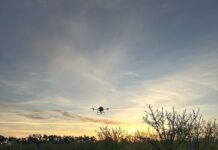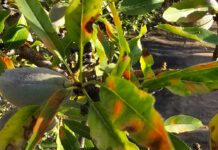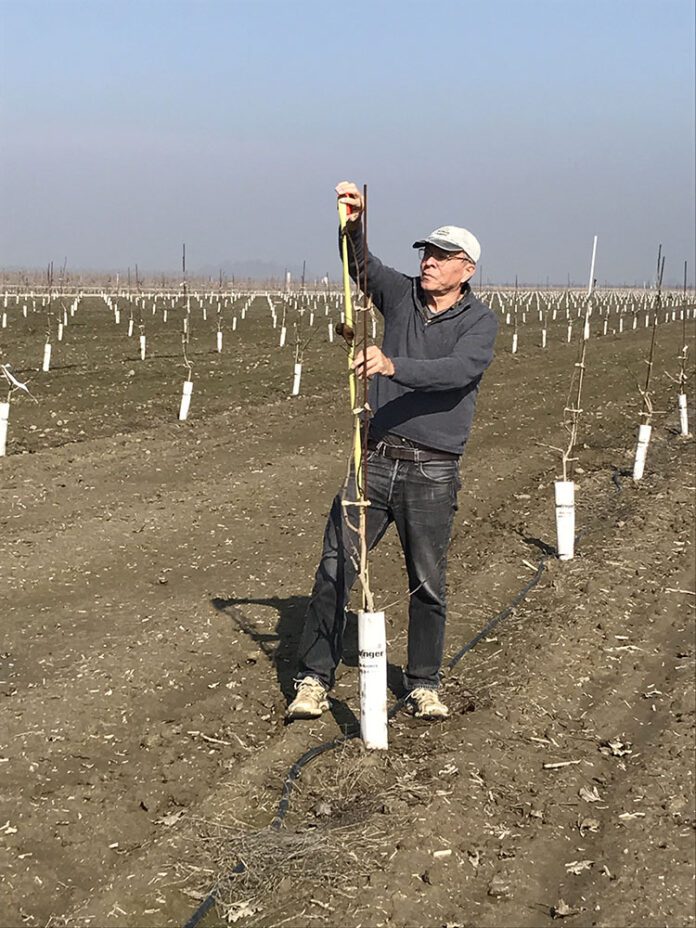
Listen to the audio version of this article. (Generated by A.I.)
After more than two decades as one of California’s leading voices in orchard management, Dr. Bruce Lampinen is closing the chapter on a career that transformed the state’s nut industry. Known for his precision, passion and tireless dedication to grower success, Lampinen leaves behind a legacy rooted in science, collaboration and real-world impact.
Talk to almost any almond or walnut grower in California, and chances are they’ve heard of, or worked with, Lampinen. His practical insights, data-driven recommendations and iconic light bar system are just part of what made him a household name in orchard management circles.
Lampinen received his bachelor’s degree in nutrition, a master’s degree in plant ecology and a doctoral degree in plant science from UC Davis. After completing his Ph.D., he conducted a postdoctoral fellowship with Steve Southwick, Dave Goldhamer, Ken Shackel, Carlos Crisosto and Astrid Volder in the Department of Plant Sciences from 1997 to 1998.
In 1998, Lampinen joined the University of Massachusetts as an extension faculty member based at the Cranberry Station in East Wareham. During his time there, he conducted extensive research on cranberry water relations and made a lasting contribution to irrigation management. He developed a simple yet highly effective water-level float to help schedule irrigation in cranberry bogs. This innovative tool, now widely adopted across Massachusetts and New Jersey, earned the nickname ‘Lampinometer’ in his honor and remains a standard in cranberry irrigation today.
In July 2000, Lampinen returned to UC Davis and was appointed as a specialist in cooperative extension.
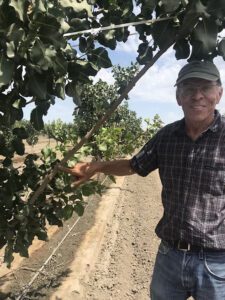
Field Research and Industry-Changing Discoveries
Lampinen’s early research centered on almond and walnut water relations, canopy management and improving food-safety practices, particularly in response to a Salmonella outbreak in Fresno County almond orchards. His work played a critical role in identifying and reducing food-safety risks both in the orchard and during postharvest storage of stockpiled almonds. His efforts contributed to the development of improved practices that helped safeguard the industry and restore consumer confidence.
Lampinen’s research evolved to explore almond spur dynamics and how they are influenced by irrigation and tree training systems. This work led to the development of a light bar tool used to measure canopy light interception in orchards. He and his colleagues deployed this tool across almond, walnut, peach, olive and pistachio orchards and even vineyards, collecting more than 25,000 data points statewide. Their findings established clear relationships between light interception, crop productivity and nut quality, providing growers with valuable benchmarks for orchard management.
Concurrently, Lampinen launched a series of long-term studies on the effects of tree spacing, training and irrigation practices on walnut productivity, nut quality and food safety. One of the most impactful outcomes was the discovery that pruning to shape walnut canopies offered minimal benefit. Initially considered controversial, his findings ultimately reshaped industry practices. Many growers transitioned to a minimal-pruning approach, removing only interfering or low-hanging limbs. Orchards managed under this system for nearly 20 years showed earlier crop production, fewer structural problems and significantly faster returns on investment, a testament to the long-term value of his research.
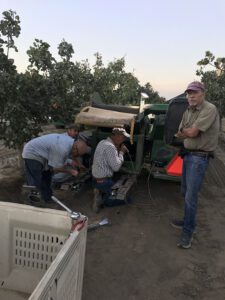
Perspectives from Peers and Growers
Dave Moore, a walnut grower, died recently but greatly admired Lampinen’s work, according to his wife, Susan Moore. “Dave did everything the way Bruce wanted with no pruning, and people around here say his orchard is the best.
“Bruce was a big help to him. Dave really liked the innovative things that Bruce did. Dave thought nature did better with trees than pruning. It was really quite interesting to watch him, and it really gave him a lot of pride in his orchard,” she added.
Brent Barton, a walnut grower who worked with Lampinen said, “I so respected that Bruce was a fearless scientist and researcher. He would formulate a hypothesis, design a project around it and then really work the data, follow the data. The whole concept of not pruning, or at least not heading walnut trees, was very foreign to pretty much all of us walnut growers, and the result has been the unheaded method and is being adopted successfully in select situations. I don’t think it applies to every situation, but we’ve learned a lot from it, and I think the industry has benefited from that work.
“Bruce was at the forefront of irrigation experimentation. Should we be watering as much as we do, or more, or less? And again, designing experiments and then following the data,” he said.
The whole concept of light interception for tree nut growers in walnuts and almonds has been very important, Barton continued. “As I look back on it now, it’s kind of intuitive but Bruce was the guy who started the conversation and again developed the data with his light bar machine.
“He leaves big shoes to fill but I’m optimistic they can be filled. Certainly there’s a lot of interest in the tree nut industry to make sure that we get a specialist in that position who can take the legacy Bruce has left and even build on it, expand on it and improve it,” Barton said.
Luke Milliron, orchard systems adviser for Tehama, Butte and Glenn counties, is a friend and colleague of Lampinen. “Bruce Lampinen is an unsung hero in California nut crop agriculture. He has massively moved the science forward for growing almond, walnut and pistachio trees. Lampinen together with his associates and grower collaborators defined the relationship between canopy size (shade on the orchard floor at midday) and yield potential in almond and walnut orchards.”
Milliron went on to say, “This work underpins almost every orchard production research project since. For example, when evaluating varieties and rootstocks, a smaller almond or walnut tree might yield less but when you see that it’s very yield efficient with their measurement it suggests you could simply pack that variety tighter and achieve excellent yields.”
The work by Lampinen showed the relationship between increased canopy and increased yield leads to reduced pruning. The non-pruning approach in almonds, walnuts and pistachios has made these industries many millions of dollars. The non-pruning approach has improved growers’ bottom lines both through reduced expenses and increased early yields, Milliron said.
Lampinen and his team have contributed in numerous other ways, Milliron continued. Examples include showing that kaolin clay for sunburn protection applications didn’t improve a Chandler grower’s bottom line and that increased water improved early yields in almond but can be overdone and lead to increased tree-to-tree variability in mature orchards.
“Bruce Lampinen is a humble figure in nut crop agriculture that will be missed by many. We will all be greatly enriched by adopting the lessons he has taught us the last couple decades,” Milliron said.
Cliff Beumel, president of Agromillora California Nursery, worked with Lampinen and said, “We started planting a series of orchards at the nursery and I wanted to work on all the things that Bruce had already been working on because I believed his work was undervalued, underappreciated and under published. I wanted to give it yet another platform where we could get data to show the things he was working on.”
Beumel respected Lampinen’s no-nonsense approach. “He always had the funniest presentations at UC Cooperative Extension days or at the Walnut Research Conference. He would just show his pictures and his data that were overwhelmingly convincing and then he’d say, ‘That’s it. Don’t prune a walnut tree,’” he said.
For Beumel, Lampinen’s research was overwhelmingly convincing. “He knew how to study things, design a trial, track it with imagery. To my mind, he didn’t come to conclusions until they were so firmly established by repeated data, and he didn’t make claims until he knew it was real.”
Mae Culumber, UCCE nut crops advisor in Fresno County, began a close collaboration with Lampinen about eight years ago.
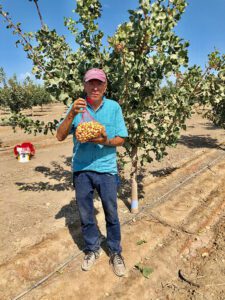
“Soon after I joined UC Cooperative Extension in 2016, Bruce invited me to collaborate with him on a young pistachio tree training study, a project that we are still monitoring today. Our research evaluates the effects of three different pruning approaches on shoot growth emergence, tree growth, water stress and yield. With multiple trial sites spread out across the Central Valley, our work requires substantial support from students and research staff. After a long day in the field, it has become a tradition to get a group picture in front of our pistachio trees, always with whatever tools we were using that day in hand. Bruce always takes the photo but sometimes we manage to get him in the frame!” Culumber said.
As a result of this work, a growing number of pistachio growers are experimenting with these simplified training techniques, drawn by the promise of earlier yields and reduced labor costs, Culumber said.
Culumber said Lampinen always had a passion for new technology and was the first one to embrace the latest and greatest innovations. “Bruce was the first person I knew with an Apple Watch nearly a decade ago, happily tracking his activity stats. Bruce gets up early, clocking his steps and miles on his daily morning walks. His love of technology along with his ingenuity and problem-solving skills has allowed him to develop creative and impactful ways of answering scientific questions in the field.”
Lampinen is fascinated by plant phenology and the timing of recurring biological events during the plant life cycle, like bud break, flowering, leaf out and fruiting, Culumber continued.
“He has spent much of his career developing techniques to understand how environmental factors and agricultural management practices influence and change these growth patterns. He introduced me to the use of a time lapse camera to measure stages of tree growth and to track shadows on the orchard floor over the course of the summer. These measurements help estimate how much light is intercepted by tree canopies, which relates to a critical measurement known as midday canopy photosynthetically active radiation (PAR). Higher PAR has a positive association with increased yield,” Culumber said.
Over the years, Lampinen has made continuous improvements to how PAR data is collected. What began with a handheld light bar evolved into an ATV mounted mobile light sensing unit, Culumber said.
“Bruce generously shared this innovation with many researchers, helping to standardize and streamline PAR measurements across orchards. He didn’t stop there in his effort to make data collection as simple as possible. He also developed a smartphone application that allows the user to obtain PAR estimates with their cell phone,” Culumber said, and he envisioned a tool that growers could also use to assess canopy size and yield potential to help fine tune irrigation and nutrient management practices.
“Even though Bruce has officially retired, I know that I will continue to learn with him in pistachio orchards. More importantly, I know we will remain lifelong friends!” Culumber said.
Lasting Legacy and Continued Innovation
Throughout his career, Lampinen has served on numerous committees and advisory boards. Notably, he served as the liaison between the California Walnut Board and his fellow researchers from 2000 to 2025 and held the UCCE presidential chair for tree nut soil sciences and plant water relations, a $1 million endowment funded by the California Pistachio Research Board and the UC Office of the President in 2016.
During his career at UC Davis, Lampinen’s lab supported a broad network of researchers (UC faculty, CE specialists, USDA researchers and UC ANR farm advisors) utilizing light bar technology to address diverse orchard management questions. He contributed to the university’s mission through 62 scientific journal articles, more than 350 extension commodity board reports, more than 375 extension presentations and three iPhone apps.
Lampinen worked with many talented people during his tenure and learned from an amazing group of dedicated, helpful people over the years. This included Dave Ramos, Bob Curtis, Warren Micke, Bob Klein, Ken Shackel, Steve Weinbaum, Maciej Zwieniecki, Tom Gradziel, Greg Browne, Roger Duncan, Rachel Elkins, Janine Hasey, Katherine Jarvis, Bill Krueger, Rick Buchner, Bill Coates, Wilbur Reil, Elizabeth Fichtner, Dani Lightle, Mae Culumber, Phoebe Gordon, Janet Caprile, Kathy Kelley, John Edstrom, Franz Niederholzer, Mario Viveros and Lonnie Hendricks.
“What an amazing group of dedicated people,” Lampinen said.
Lampinen received more than $22 million in funding as PI or co-PI, including $6 million from commodity boards with strong support from state and federal grants. All this work was carried out in close collaboration with the California tree nut industry.
Throughout his career, Lampinen focused on developing practical, research-based solutions that improve orchard productivity and sustainability. “I think the work my research group has accomplished has given a strong basis for others to continue work on improving productivity, quality and sustainability for California tree nut crops,” he said.
Lampinen is currently working on summarizing all the light interception and yield data collected across hundreds of almond, walnut and pistachio orchards.








